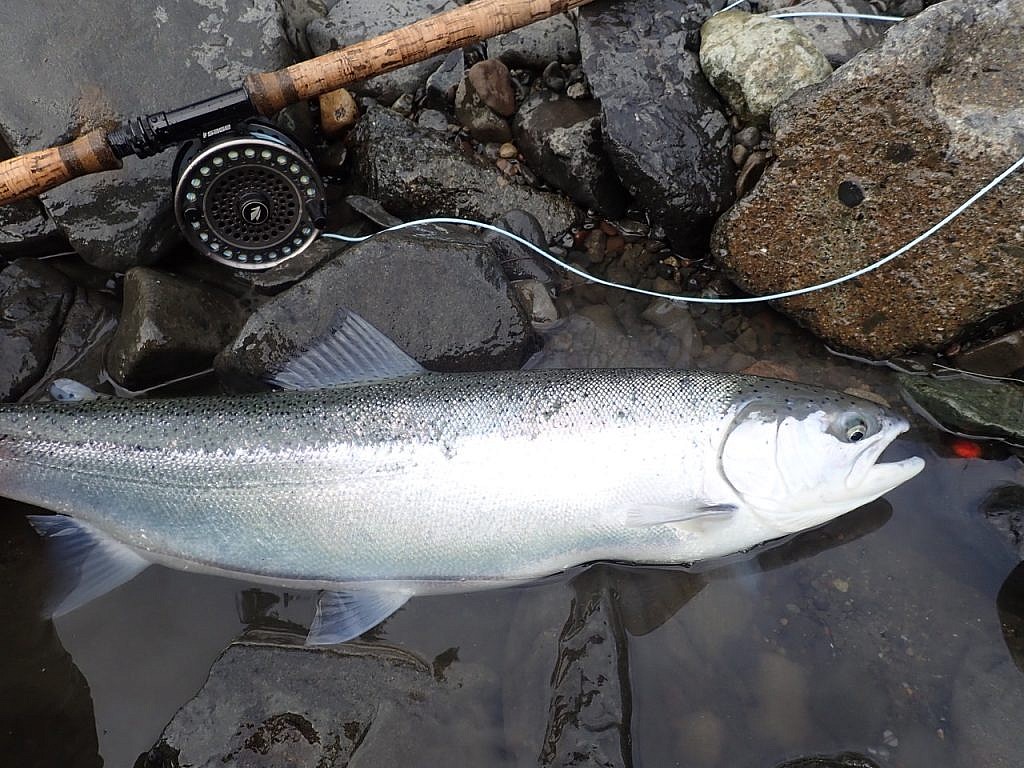
by Scott Sadil
Two recent bits of news offer further insights into the state of Pacific Northwest steelhead, for decades the iconic prize sought by fly fishers throughout the region.
Following a trail of evidence from studies that continue to question the validity of federal and regional hatcheries as a means to support and protect endangered runs of steelhead, a recent study out of Oregon State University showed that hatchery-raised steelhead “have offspring that are good at gaining size but don’t survive as well in streams as steelhead whose parents are wild fish.”
A hatchery, in other words, favors genes that promote growth in a hatchery environment – at a cost to survival in the wild.
More succinctly, the results of the study, published in the journal PLOS One, make evident, once again, the probability that hatcheries, in the long run, do more harm than good.

Michael Blouin, professor of integrative biology at OSU and lead author of the study, offers this assessment of findings from this and other hatchery studies he’s conducted: “A hatchery environment has no predators, lots of calorie-dense food and is very crowded. But a natural stream is a low-food, predator-filled environment. Behaviors or physiological traits that allow some juvenile fish to take advantage of the hatchery and grow quickly might make them prone to starvation or being eaten by predators in the wild.”
Which is just part of the reason, in a related bit of news, that a coalition representing both conservation and fishing groups has petitioned the Oregon Department of Fish and Wildlife to stop planting hatchery-raised summer steelhead smolts in Oregon’s North Umpqua River, the most famous and, probably, most historically significant steelhead river in the sport of fly fishing.

The problem, petitioners claim, is that too many hatchery fish are now spawning in the North Umpqua, while at the same time the number of wild summer steelhead, returning to spawn, has crashed.
Crashed? Like in 347 wild fish – 347 – returning last fall to spawn.
The number alarms everyone. The coalition wants action. ODFW’s own information, they say, shows that 33 percent of summer steelhead on spawning grounds in the river are hatchery fish, a violation of the state’s management plan, which calls for hatchery fish making up ten percent or less of spawning fish.
The coalition adds that in and near Rock Creek, a tributary of the North Umpqua and site of a hatchery, more than 75 per cent of spawning fish are of hatchery origin.
ODFW’s response? Shaun Clements, ODFW Deputy Administrator for Inland Fisheries, had this to say: “Regardless of the petition, I can share that our research staff were already in the process of completing a comprehensive analyses (sic) of wild summer steelhead health in the basin. Based on the science, we will adapt our management and take corrective actions necessary, including for the hatchery program.”
Stop me if you’ve heard this before. As dams went in, hatcheries were built near more of them than you can count, allegedly to mitigate the loss of spawning habitat above these power- and profit-generating facilities. Hatcheries became an integral part of fish management – and an industry unto itself. Good jobs: I suspect I might have had a lot more fun raising salmon and steelhead than trying to teach subject-verb agreement to high school sophomores.
But from all we can tell at this point, hatcheries haven’t worked. Not without attending to the problems created by dams, the degradation of habitat. Fish, as Jim Lichatowich explained in Salmon without Rivers: A History of the Pacific Salmon Crisis, need healthy rivers.
What the coalition would like to see, says Kirk Blaine of the Native Fish Society, one of the coalition petitioners, is the North Umpqua managed as a wild-steelhead watershed, with no hatchery fish at all.
The question, it seems to me, is whether it’s nothing short of hubris to believe we can somehow replicate whatever genius is bundled up in each and every steelhead in a healthy run of native fish.
From where I stand, the answer’s pretty clear.
_____________________________________________________________________________________________________________
Gray’s Angling Editor Scott Sadil caught his first steelhead 30 years ago on the North Umpqua.
